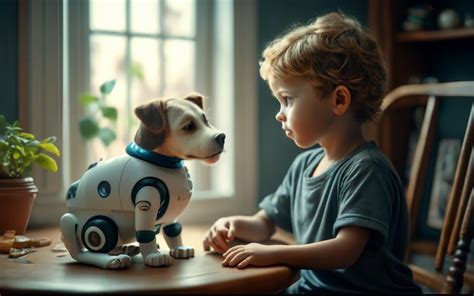Introduction
Loneliness and isolation have become pervasive societal issues, particularly among the elderly and individuals living alone. Traditional pet ownership, while fulfilling, comes with limitations and responsibilities that can be challenging to manage. The advent of artificial intelligence (AI) has opened up new possibilities for companionship, with AI robot pets emerging as a potential solution.

The Rise of AI Robot Pets
The global market for AI robot pets is projected to reach $5.5 billion by 2025, according to Grand View Research. This rapid growth is driven by increasing demand for companionship, advances in AI technology, and the declining cost of production.
AI robot pets offer numerous advantages over traditional pets, including:
- Convenience: They require minimal care and maintenance, eliminating the need for feeding, grooming, and veterinary visits.
- Customization: They can be programmed with specific preferences, personality traits, and interactions to suit the user’s needs.
- Safety: They pose no health risks or allergies and can be kept in small spaces without causing disruption.
- Emotional support: They provide companionship, laughter, and a sense of purpose, particularly for those who may lack human interaction.
Benefits of AI Robot Pets
For the Elderly
AI robot pets can provide much-needed companionship and socialization for seniors. They reduce loneliness, stimulate cognitive function, encourage physical activity, and promote emotional well-being.
For Individuals Living Alone
AI robot pets offer a sense of security and companionship to individuals living alone. They can provide comfort, interact with them, and offer assistance with daily tasks.
For Families with Children
AI robot pets can be an educational and entertaining addition to families with children. They teach children about responsibility, empathy, and the importance of caring for others.
Addressing Concerns and Pain Points
Cost: AI robot pets are still relatively expensive, which can be a deterrent for some users. However, their long-term cost-effectiveness, compared to traditional pets, should be considered.
Technological Limitations: Current AI robot pets may have limited capabilities and may not be able to provide the same level of companionship as a living animal. However, ongoing research and development are rapidly improving their abilities.
Emotional Connection: While AI robot pets are designed to provide emotional support, they cannot fully replicate the complex emotions and interactions of human-animal bonds.
Future Frontiers: AI-Powered Pet Care
Smart Pet Feeders: AI-powered pet feeders can monitor food levels, track feeding schedules, and dispense food automatically, ensuring pets are fed regularly and preventing overfeeding.
Wearable Pet Devices: GPS trackers, activity monitors, and health sensors attached to pets can provide real-time data on their well-being, enabling owners to detect any issues promptly.
Telemedicine for Pets: AI-powered telemedicine platforms allow pet owners to consult with veterinarians remotely, eliminating the need for in-person visits and providing access to care even in rural areas.
Conclusion
AI robot pets are transforming the landscape of companionship, offering a range of benefits to individuals and families. While concerns and challenges exist, the potential for AI-powered pet care is immense. As technology continues to advance, AI robot pets will become increasingly sophisticated, accessible, and emotionally engaging, providing a new level of companionship and support for humans in the years to come.
FAQs
Q: Are AI robot pets a good replacement for traditional pets?
A: No, AI robot pets are not intended to replace traditional pets but rather provide an alternative form of companionship.
Q: How do AI robot pets help with emotional support?
A: They provide companionship, reduce loneliness, and stimulate emotional engagement through interactive conversations and programmed responses.
Q: What are the long-term benefits of owning an AI robot pet?
A: They can promote well-being, reduce healthcare costs, and enhance quality of life, particularly for the elderly and individuals living alone.





















